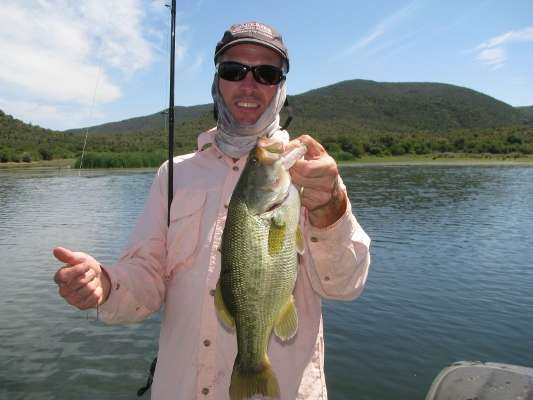
Fewer than 50 largemouth bass were moved to South Africa in the early 1900’s. From those few fish, bass have now spread into nearly all the reservoirs in the country. See my photos.
With the fish came the fishing industry. Bass fishing is a popular sport in South Africa. I recently visited there (with some financial support from B.A.S.S. Conservation), and wow, I was impressed. Tour guide Alfie Curling took me bass fishing on a lake in Kwandwe Game Preserve, and we cast spinnerbaits and plastic frogs as elephants roamed the hills above. A 5-foot monitor lizard crawled off a cliff and swam across the creek, while baboons looked down on us from atop the bluff. Holy cow, this isn’t bass fishing in Kansas!
Over the next few days, I attended an 80-boat bass tournament on Wriggleswade Reservoir and was amazed by what I saw. Outstanding bass boats were everywhere, many of which were locally made in South Africa and others imported from the United States. On the decks of these boats were identical rods, reels and lures to what we find at home. Anglers here are well-versed in the latest tackle crazes, including tungsten sinkers, mojo rigs and Carolina rigs — in Africa! The big bass of the tournament was a 6 1/2-pound largemouth caught on a black buzzbait. Talking to the anglers, it seemed like the best lures were exactly what you would expect for a relatively muddy water reservoir in the Midwestern United States. Spinnerbaits, crankbaits and flipping were common techniques, with timber and hyacinth mats being the most common cover targeted by anglers.
Anglers here are passionate about their bass fishing, and it also made me realize how lucky we are to have fisheries management agencies here in the USA. In South Africa, bass are a non-native, invasive species and there is literally no management in place to protect and improve these fishery resources. There are no size limits or bag limits, although most tournament anglers practice catch and release. If a lake gets too many carp and loses all aquatic plants, there is no agency to call for help. The bass anglers in South Africa are well-organized and enthusiastic, but they don’t have the help of state management agencies like we have here at home. The South African Bass Anglers Association (S.A.B.A.A.) helped fund my visit, in part because they want to learn more about how to manage populations for better fishing.
Fisheries biologist Dr. Olaf Weyl of the South African Institute for Biodiversity was my host, and his group is doing the type of work that many fisheries agencies do here at home. His graduate student Gerry Taylor has evaluated bass growth, mortality and recruitment patterns in reservoirs. Dr. Weyl’s group also does extensive work to protect native stream fish from impacts of bass predation.
Despite a lack of active management, fishing in many South African reservoirs is good to excellent, with catch rates that appear to be to similar to what we find here at home. I saw lakes that were clear with vegetation and some that were muddy with nearly no plants, and several in between. Most reservoirs here are small by comparison to the USA, with a 3,000-acre reservoir being large here.
I was impressed with the passion of the anglers here, and it was certainly easy to strike up a conversation about fishing in South Africa. Special thanks to Olaf and S.A.B.A.A. for hosting me in this amazing country.
